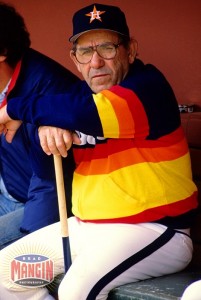
You’re damned right I’d follow Billy Martin’s mustache, and his spectacles, into the heat of baseball battle.
Adding to Martin’s lore: Whiskey Slick, his nickname, according to Baseball Almanac. And Whiskey Slick loved an old fashioned fracas, or ten, I learned, after going down the rabbit hole that is Billy Martin’s Wikipedia entry.
Witness:
Martin was well known for drinking to excess and for rowdy behavior when drinking. In 1957, a group of Yankees met at the famous Copacabana nightclub to celebrate Martin’s 29th birthday; the party ultimately erupted into a much publicized brawl when Martin, Hank Bauer, Mickey Mantle and Yogi Berra challenged a few drunks who were hurling racial slurs at performer Sammy Davis, Jr. A month later, general manager George Weiss—believing Martin’s nightlife was a bad influence on teammates Whitey Ford and Mickey Mantle—exiled him to Kansas City. Martin felt betrayed by Stengel, with whom he had a strong father-son relationship, for failing to prevent the trade, and the two did not speak for years.
Exile in Kansas City. The more things change …
A few years later:
On August 4, 1960, Martin, then playing for the Reds, charged the mound in the second inning after receiving a brushback pitch from Chicago Cubs pitcher Jim Brewer. Martin threw his bat at Brewer, who picked up the bat and started to hand it to Martin as he approached. Martin punched Brewer in the right eye, breaking his cheekbone. Brewer was hospitalized for two months, and Martin served a five-day suspension. The Cubs sued Martin for $1,000,000 ($7,416,009 as of 2011), for the loss of Brewer’s services. While the Cubs dropped their case, Brewer pursued his, and in 1969, a judge ordered Martin to pay $10,000 ($59,909 as of 2011), in damages. When informed of the judgment by the press, he asked sarcastically, “How do they want it? Cash or check?”
Martin’s fights as a player also included bouts with Jimmy Piersall, Clint Courtney (twice), Matt Batts and Tommy Lasorda.
There’s no way you can convince me that Martin didn’t pay his fine in cash.
There’s more:
In 1969, Martin’s only season as manager of the Twins, he won a division championship. He was fired after the season following an August 1969 fight in Detroit with one of his pitchers, Dave Boswell, in an alley outside the legendary Lindell A.C. bar.
Ten years later, Martin hadn’t mellowed:
After the 1979 season, Martin got into a fight with marshmallow salesman Joseph Cooper at a hotel in Minneapolis.
Marshmallow salesmen are the worst.
Moving on:
On September 22, 1985, while at a hotel bar in Baltimore, Maryland, Martin fought one of his pitchers, Ed Whitson, who broke one of Martin’s arms.
And here I thought the 2006 scuffle between then Toronto Blue Jays manager John Gibbons and Ted Lilly was the stuff of dreams.
Finally:
Martin’s sparring opponents as a manager also included two traveling secretaries (Minnesota’s Howard Fox and Texas’ Burt Hawkins) in a fight outside of Howard Wong’s in Bloomington, Minnesota; Jack Sears, a fan outside Tiger Stadium; a Chicago cab driver who preferred soccer to baseball; sportswriter Ray Hagar, in a Reno indoor arena bar; … two bar patrons, in Anaheim and in Baltimore; and two bouncers in an Arlington topless bar.
I shudder to think what might have become of a marshmallow salesman who moonlighted as a cab driver, and who preferred the beautiful game to baseball, had he crossed Billy Martin’s path.
Interesting cat, Billy Martin, to say the least. And I had no idea.
Image courtesy Baseball Almanac, “Where what happened yesterday is being preserved today.” They ain’t foolin’.







